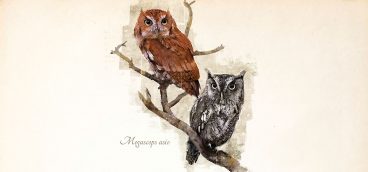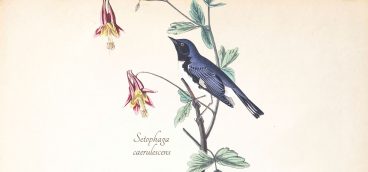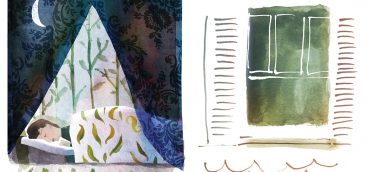
“From the porch at dusk I watched a kingfisher wild in flight he could only have made for joy…” —Wendell Barry (from his poem “Before Dark”)
One summer day not long ago, I sat on the front porch of our farmhouse. It’s a log house, built about 1860 and added onto over the years—a happy home where my husband and I raised two children and a menagerie of animals: horses, cows, goats, a lamb and a bunny, chickens and the requisite dogs and cats. We have a vegetable garden, hayfields, walking trails and a barn. Below the house is a small pond with a simple wooden dock, on which sits a lone red Adirondack chair.
That morning I noticed something draped across the front of the chair. Something dark. Perhaps a sweatshirt left by my husband, who likes to run in the woods in the early morning and often sits there with the dogs to cool off. Or maybe someone had forgotten a towel after a swim. I was curious so I walked downhill to investigate —across the lawn, under the gnarled apple trees, through the gate in the stonewall, by the metasequoia and the maple. As I got closer, I could tell that the object was neither sweatshirt nor beach towel, but I still couldn’t tell what it was. Bluish-grey, with a curious black-and-white pattern on it, the dark mass was in crisp contrast to the bright red chair.
It was a perfect specimen of a Belted Kingfisher.
My husband and I have an odd affinity for predominately black and-white birds (or dark blue): Oystercatchers, Magpies, Arctic Terns, Black-winged Stilt, Loons, and Great Black-backed Gulls, among others. I’m not sure where that comes from— probably birding trips early in our marriage before the children were born—but we have framed prints of these birds in a bathroom in our house. One of our favorites is the Belted Kingfisher with its distinctive rattling call and its ability to dive from great heights—20-40 feet—straight down into water to catch prey, usually fish and crayfish. Its head is wildly crested—to me, an amusing punk hairdo—which gives the bird a confidant air. And I like the Belted Kingfisher in particular because it’s one of the few birds where the female is more colorful than the male.
My visitor was about a foot long, with white bars on its black wingtips, white polka-dots on black tail feathers, and a rustcolored ring around its neck. Somehow it had achieved a direct bull’s-eye through the chair’s vertical slats, a narrow 7/8 of an inch. Its wide wingspan resembled a Native American headdress, which was splayed across the front of the chair. On the back of the chair, only the bird’s head and long bill were visible.
“I’ve never heard of a bird getting stuck in a chair,” said Luke DeGroote, avian research coordinator at Powdermill Nature Reserve in Rector. I asked him what might have happened. Was the Belted Kingfisher hunting something and lost its direction? Diving and got confused? How could it not have seen a bright red chair? DeGroote surmised that the bird was being chased by a predator, probably a raptor of some variety—most likely in our area a Merlin, Peregrine Falcon, or a smaller hawk such as a Goshawk, Broadwing, or a Cooper’s. He identified the bird as a young female hatched that spring, as indicated by its rust-colored belt and the rust feathers in the neckband. Powdermill’s director, John Wenzel, kindly came and fetched the bird; at least, I hoped, it might be used for education or research.
Still haunted by the image of the bird’s demise and wanting to know more, I sent photographs to The Cornell Lab of Ornithology in Ithaca, N.Y. Kevin McGowan, an online education specialist there, and an instructor of a home study course in bird biology, said he didn’t think the Belted Kingfisher’s skull would have fit directly through such a small opening in the slats. Instead, he said, the bird must have been attacked directly above the chair, or collided with the chair higher up, and slipped down into the gap. From Cornell’s websites, I learned that Belted Kingfisher males fiercely defend their territories, and that females are often more aggressive and territorial than males during the breeding season. Strong competition has been observed between females “in which a younger bird was driven from her territory and her eggs dumped.” Was this the fate of my Belted Kingfisher?
I kept researching and discovered that the Belted Kingfisher is an unusual bird in many ways: it builds nests by burrowing into banks—streams, ponds, even roadsides. Its eyes are closed when it hits the water. And after mating, the male gives a show near the water’s surface—gliding and diving, then recovering, extending its wings and flashing the white on its feathers. Young Belted Kingfishers have stomachs with a high acid content to digest fish scales and bones, but by the time they leave the nest their stomach chemistry changes and they regurgitate food. Belted Kingfishers are monogamous during each mating season. Having just seen the downfall of one female, and having learned that 233 U.S. bird species are in need of conservation, I worried that our Belted Kingfishers might be endangered. But DeGroote said no. “They’re pretty abundant, and good at what they do.”
The kingfisher, of which there are three varieties in North America and about 90 worldwide, is also a bird full of legend. In Native American mythology the Kingfisher symbolizes many beliefs: peace and prosperity in some tribes, fertility in others. In the Makah tribe on the Olympic Peninsula, legend says that a human thief was punished by being turned into a Kingfisher. In Greek mythology, when Alcyone discovers that her husband has drowned, she hurls herself into the sea in grief, and the Gods turn her and her husband into Kingfishers. Then Alcyone’s father, Aeolus, king of the winds, stops the wind from blowing for seven days on either side of the winter solstice, when some Kingfishers lay eggs. We know this period as “Halcyon Days,” or, according to the Cambridge English Dictionary, “a very happy or successful period in the past.” (The Latin for Belted Kingfisher is Megaceryle alcyon and Tree Kingfishers are the genus Halcyon.)
Sitting on my porch, I have heard the rattle of the Belted Kingfisher many times since—by the pond, at the edge of the woods, near the stream deep in the forest, but I have yet to see another one. I have searched the pond’s bank for a burrow, but found none. Still, I know they are here, alive and—I hope—flourishing. Especially in this uneasy time of political rancor and economic difficulty, I choose to believe that western Pennsylvania’s Belted Kingfishers are predicting peace and posterity to this farm—and to us all.
To learn more about the Belted Kingfisher visit:
Powdermill: carnegiemnh.org/powdermill
Cornell Lab of Ornithology: allaboutbirds.org
2014 State of Birds Report: archive.stateofthebirds.org/state-of-the-birds-2014-report/





